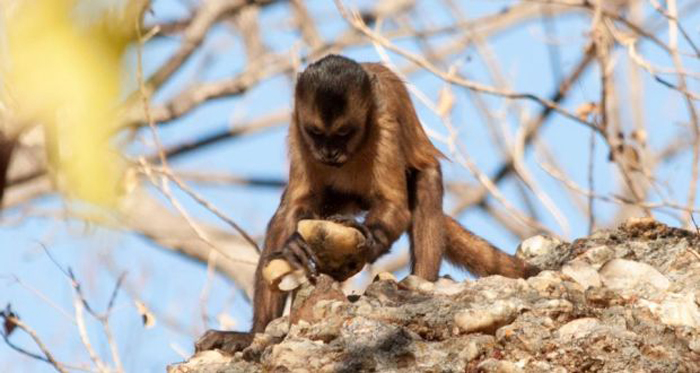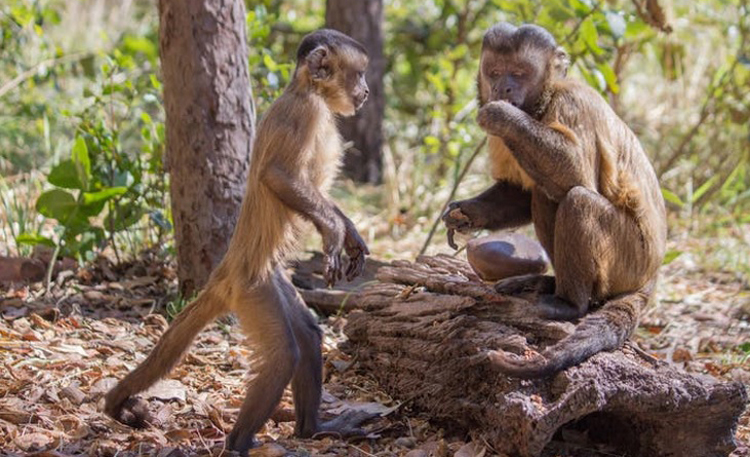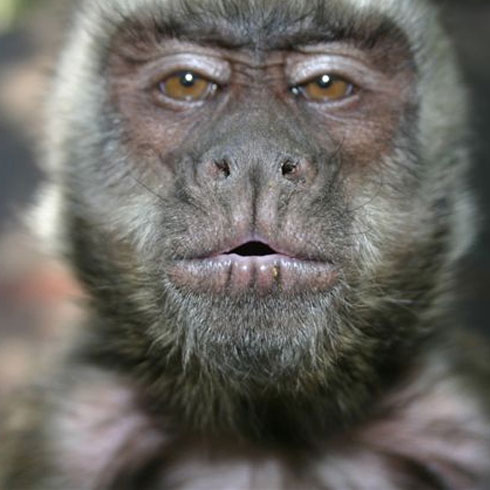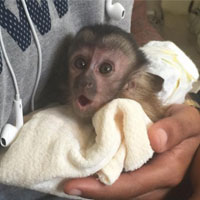
Humans, and only humans, were thought to use and make tools, defined as "Man the Tool Maker."
Then one day in October of 1960, Jane Goodall found a chimp squatting on a termite mound. He seemed to be poking pieces of grass into the mound, then raising them to his mouth. Termites bit onto the modified grass stem with their jaws. The chimp had been using the stem as a tool to "fish" for insects!
Tooling is defined as the process of using an object to achieve a mechanical outcome on a target.
Monkeys using tools
Understanding wild animals’ memory, thinking and problem-solving abilities prove to be no easy task. For a start, there should be no distractions – like a predator popping up. Wild animals come and go as they please over vast distances and researchers have no control over what is happening around them, like that threat by a predator, for instance.
Bearded capuchin monkeys (Sapajus libidinosus) naturally use stones and anvils to crack open nuts. This behaviour might be related to food availability.

Young capuchin monkey observes adult male monkey eating nuts cracked open using a stone tool. Luca Antonio Marino,
Along with fruit, insects, fungi, and tubers capuchin monkeys opportunistically crack open nuts as an additional food source. Although they only spend about 2% of their time using tools to access foods, the nuts they eat are an important secondary food item that is available year-round. However, the challenge in cracking these nuts comes in the form of tough shells that can’t be cracked open without a tool. Capuchin monkeys have figured out how to crack nuts by placing them on a wood or stone anvil and then smashing them with rocks. Since discovering their toolmaker abilities, researchers were curious about the decision-making and strategies involved in capuchins’ stone tool use.
What happens with a new tool?
These monkeys had to gain an understanding of preparing how to use their tools. And lo and behold, just as a person might move their hands around a box to decide how best to lift it, these monkeys feel their way through tool use.
How do they do it?
Research showed that nut-cracking, monkeys grasp the sides of a stone, lift it to shoulder height, quickly move its hands to the top of the stone, then bring it down on the nut. Given that the stones can weigh about half as much as an adult female monkey, this is an impressive feat.
Unfortunately for these hungry primates, this technique did not work always worked perfectly because if the monkey’s grip isn’t right, she might lose control of the stone, and if the stone comes down at an angle the nut is likely to fly off the anvil. Apart from losing a prized treat, the monkey then lost precious time and energy whilst trying to achieve its goal. However, clever as they are, they first do a test-run; partially lifting the stones to test different grips until they found the one that’s most likely to be successful.
This same sort of dexterous behaviour in humans may have contributed to advancing tool use, giving an exciting glimpse into what human evolutionary history may have looked like, while also helping us to better understand animals in their own right.
By observing monkeys smashing nuts with stones gave us a hint at how human tool use evolved.


 Conservation in Southern Africa is rapidly becoming unsustainable without the active involvement of the community, especially the younger, more active generation. The Bushbabies Monkey Sanctuary and The Elephant Sanctuary group strongly believe that we have to get the younger members of communities involved to instill a passion for the environment and wildlife in them through education.
Conservation in Southern Africa is rapidly becoming unsustainable without the active involvement of the community, especially the younger, more active generation. The Bushbabies Monkey Sanctuary and The Elephant Sanctuary group strongly believe that we have to get the younger members of communities involved to instill a passion for the environment and wildlife in them through education. I'll introduce you to Joyce, for example. A young female capuchin, she was rather pampered with child-like paraphernalia; a dress and a small hat around her head. Cute, indeed. She had been with her "foster" family since only two months old, bought straight from a breeder. The couple who owned her did not have children, and so decided to substitute the missing link with a primate, albeit a bit smaller...and with sharper teeth.
I'll introduce you to Joyce, for example. A young female capuchin, she was rather pampered with child-like paraphernalia; a dress and a small hat around her head. Cute, indeed. She had been with her "foster" family since only two months old, bought straight from a breeder. The couple who owned her did not have children, and so decided to substitute the missing link with a primate, albeit a bit smaller...and with sharper teeth.



